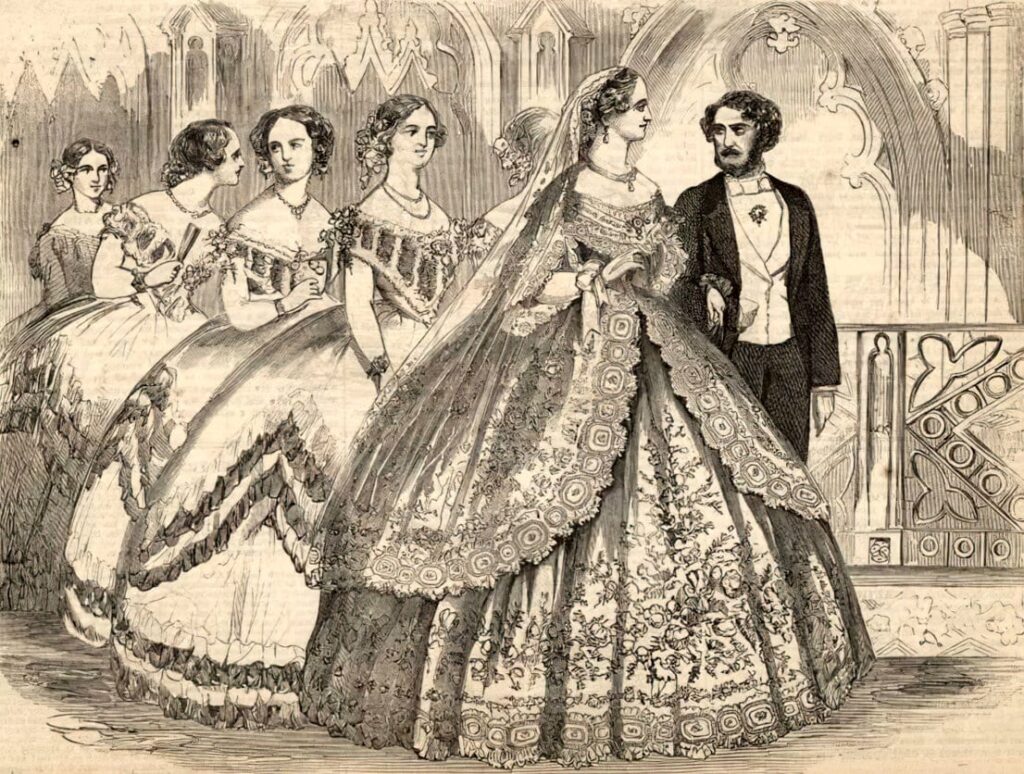One of the things that is so well-loved about stories like Cinderella and similar fairy tales is the rags-to-riches trope. This…is not that. This is riches-to-greater-riches, and then an insulting poem! Here’s what happened.
The Bride, The Groom, and The Jewels
On October 13, 1859, 18-year-old Frances Amelia Bartlett married 55-year-old Cuban planter Don Esteban Santa Cruz de Oviedo.
Oviedo was worth $135 million in today’s money, and he’d gifted Miss Bartlett many valuable things, including, infamously, 75 robes (dresses). Miss Bartlett was described as, quite literally, the belle of the ball in many places. The New York Times reported their wedding as “an epoch in our social history.”
The New York Times also reported that on her wedding day, Miss Bartlett wore the following necklace: “four rows of shapely Orient pearls, looped into a festoon by one slight rib of gleaming diamonds, gathered into the likeness of a knot of love. From this knot depended a single pear-shaped pearl, dipped in diamonds of surpassing lustre and beauty.”
“The bride received a magnificent parure [suite of matching jewelry] created by Tiffany & Co. composed of pearls and diamonds unlike anything previously seen outside of the courts of Europe. Ball, Black & Co. also created elaborate jewels for the bridal trousseau.” (American Jewelry University)
Thousands lined the streets just to get a glimpse of Miss Bartlett’s beauty, apparently comparable to Empress Eugenie, never mind her incredible wedding attire. Her Paris dress is reported as being worth (in today’s money) $219,850, while her diamonds were worth about $3.6 million (today’s money).


The Poem that Started a Controversy
Enter the satirical poem “The Diamond Wedding”, published by The New York Tribune and written by Edmund Clarence Stedman. It’s very long, but a highlight of it is the following:
But now, True Love, you’re growing old—
Bought and sold, with silver and gold,
Like a house, or a horse and carriage![…]
I do not wish to disparage;
But every kiss Has a price for its bliss,
In the modern code of marriage.
Everyone knew who this poem referred to, and it was quite controversial.
A Duel for a Retraction
Unsurprisingly, Mr. Washington A. Bartlett, the bride’s father, demanded a retraction, since it directly insults his daughter. Guess what the suggested resolution was? Stedman offered to fight a duel against Bartlett. He declined because Stedman was below his station.
A Different Second Marriage
Here’s an interesting tidbit. Oviedo died 11 years (1870) after he and Miss Bartlett were married. In 1882 Miss Bartlett was remarried to baron and colonel Bodo von Glümer, and her wedding was unadorned, small, and she left her hair with gray streaks in it (admirable!).
Unfortunately the second marriage didn’t work out; Miss Bartlett got a divorce only 5 years later in 1887.
Thank you for reading! If you’re interest in the Victorian time period, check out my Victorian suspense and Victorian fantasy books and short stories.
Resources
Image: “The Diamond Wedding at St. Patrick’s Cathedral, October 13, 1859: Portraits of the bride in her superb bridal costume, the bridegroom and the bridesmaids”
- “The Diamond Wedding” by Edmund Clarence Stedman, originally published in The New York Tribune
- “From the Archives: The New York Times Sheds Light on a Rather Poetic 1859 ‘Diamond Wedding'”, Poetry Foundation
- “The Marriage of the Season”, The New York Times. October 4, 1859.
- “The Diamond Wedding Recalled”, The Queanbeyan Age. November 19, 1887.
- “American Jewelry: Part III”, Lang Antiques: American Jewelry University.

